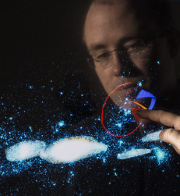A 3D Interface for Synchronous Collaboration in Distributed Augmented Reality Environments
Master's thesis by Pieter Bruining

This thesis designs a new kind of interface for augmented reality. Augmented reality is currently not commonly used, but using it can have many advantages. It can, for example, overlay ground cables while digging. The crane operator would be able to see the cables when they are buried. Another example is overlaying an MRI scan during an operation. The surgeons would have more detailed information on where to operate. Also in the field of architecture, a building can be shown using augmented reality which gives the architects or observers a good understanding of how the building is going to look like. The interface designed in this thesis focuses on collaboration. Collaboration between, for example, the architects showing their building to an observer (client). With this interface the architects would be able to adapt the building to the wishes of the client while discussing it.
The interface exists in a 3D environment which is placed in the real world using augmented reality. To make augmented reality more available for common use, a limit is set on the hardware. The hardware that is required must be inexpensive, this places serious limitations on the hardware selection. The interface is focused on collaboration between its users which means interaction is required. But, in order to have interaction an input device is required. 3D input devices often require expensive hardware which must be omitted. Therefore, the hand of the user is used to form an input device in order to realize the interaction. The interface is designed in such a way that users do not have to learn explicitly how to operate the interface because people in general are not expected to have many knowledge of 3D interfaces. The properties of the interface are tested with several experiments and the results look promising.

